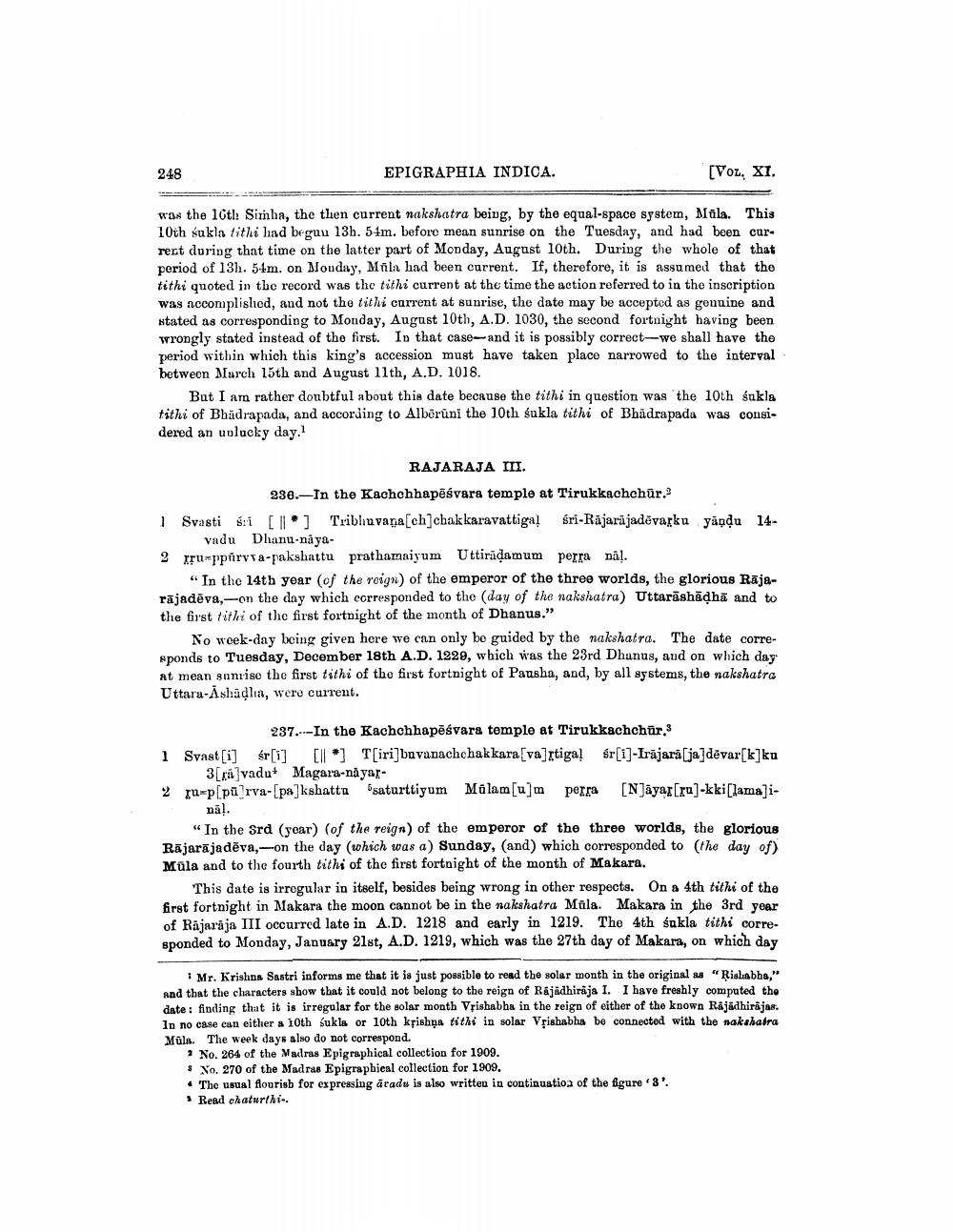________________
248
EPIGRAPHIA INDICA.
[Voz, XI.
was the 10th Simba, the then current nakshatra being, by the equal-space system, Mäla. This 10th sukla tithi had beguu 13h. 54m. before mean sunrise on the Tuesday, and had been corrert during that time on the latter part of Monday, August 10th. During the whole of that period of 13h. 54m. on Mouday, Māla had been current. If, therefore, it is assumed that the tithi quoted in the record was the tithi current at the time the action referred to in the inscription was accomplished, and not the tithi current at sunrise, the date may be accepted as genuine and stated as corresponding to Monday, August 10th, A.D. 1030, the second fortnight having been wrongly stated instead of the first. In that case and it is possibly correct--we shall have the period within which this king's accession must have taken place narrowed to the interval between March 15th and August 11th, A.D. 1018.
But I am rather doubtful about this date because the tithi in question was the 10th sukla tithi of Bhadrapada, and according to Albörūni the 10th sukla tithi of Bhadrapada was considered an uplacky day?
RAJARAJA III. 230.-In the Kachchhapēśvara temple at Tirukkachchūr. I Svasti si [1] Tribhuvana[ch]chakkaravattiga! sri-Rājarajadēvarku yāṇdu 14
vadu Dhanu-naya2 ru-pparvva-pakshattu prathamaiyum Uttiradamum perra nal.
“In the 14th year of the roign) of the emperor of the three worlds, the glorious Rājarājadēva,-on the day which corresponded to the day of the nakshatra) Uttarāshādhā and to the first tithi of the first fortnight of the month of Dhanus."
No week-day being given here we can only be guided by the nakshatra. The date corresponds to Tuesday, December 18th A.D. 1229, which was the 23rd Dhunus, and on which das at mean sunrise the first tithi of the first fortnight of Pausha, and, by all systems, the nakshatra Uttara-Ashādha, were current.
237...-In the Kachchhapēśvara temple at Tirukkachchar.3 1 Svast[i] śr[i] [*] T[iri]buvanachchakkara (va]rtiga! Sr[i]-Irājară [ja]dēvar[k]ku
3[ra vadu+ Magara-näyarrump parva-[pa]kshattu saturttiyum Môlam[u]m perra [N]ayar[ru]-kki[lamali
nal.
"In the Srd (year) (of the reign) of the emperor of the three worlds, the glorious Rājarājadēra, -on the day (which was a) Sunday, (and) which corresponded to the day of) Mula and to the fourth tithi of the first fortnight of the month of Makara.
This date is irregular in itself, besides being wrong in other respects. On a 4th tithi of the first fortnight in Makara the moon cannot be in the nakshatra Māla. Makara in the 3rd year of Rajaraja III occurred late in A.D. 1218 and early in 1219. The 4th sukla tithi corresponded to Monday, January 21st, A.D. 1219, which was the 27th day of Makara, on which day
1 Mr. Krishna Sastri informa me that it is just possible to read the solar month in the original as "Rislabha," And that the characters show that it could not belong to the reign of Rajadhirija I. I have freshly computed the date: finding that it is irregular for the solar month Vrishabha in the reign of either of the known Rajadhirajas. In no case can either a 10th Sukla or 10th krishna tithi in solar Vpishabha be connected with the nakahara Müla. The week days also do not correspond.
* No. 264 of the Madras Epigraphical collection for 1909. : No. 270 of the Madras Epigraphieal collection for 1909. • The usual flourisb for expressing aradu is also written in continuatioa of the figure '3'. » Read chaturthi..




